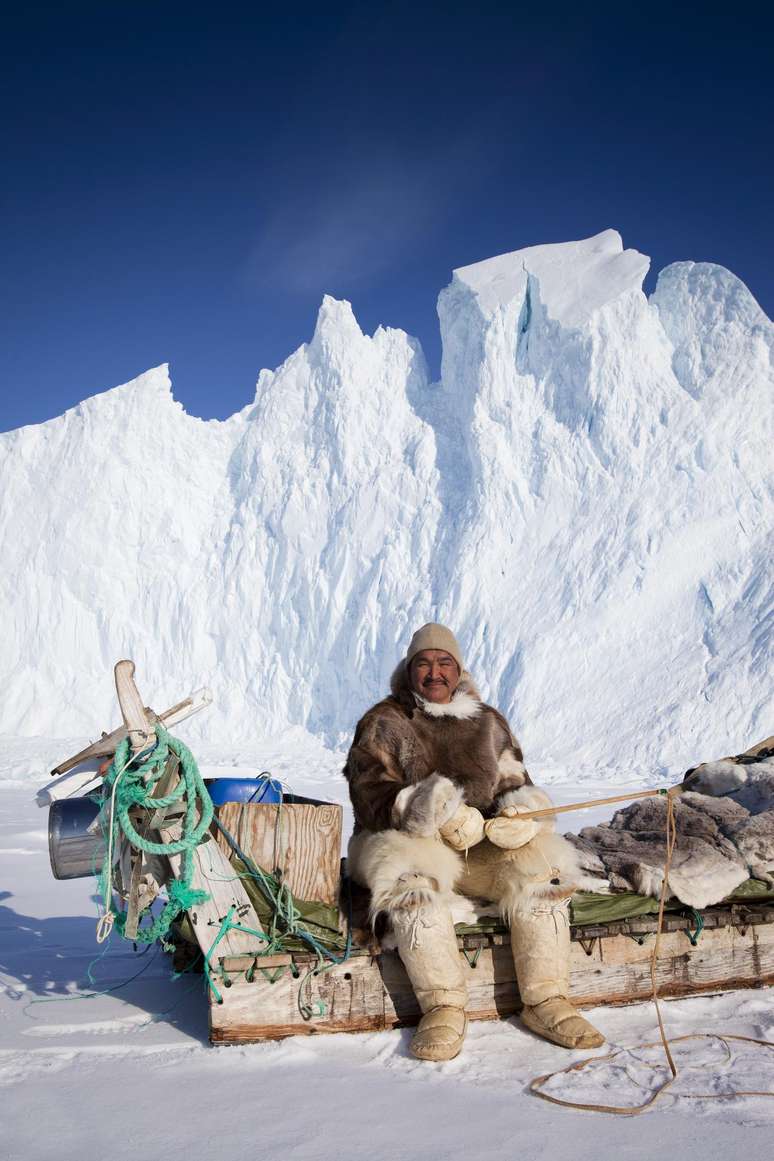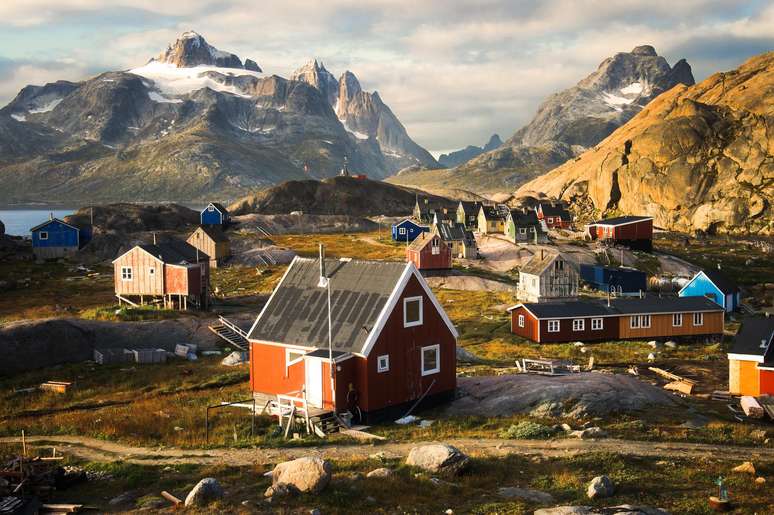Living in Greenland is not easy, but its inhabitants are in tune with nature to face the inhospitable and isolated environment.
Few things in the world leave us more impressed by nature than sleeping on a 3 km thick block of ice, resting on a layer of snow formed more than a million years ago.
Camp Ice Cap, near the town of Kangerlussuaq in West Greenland, offers the amazing opportunity to camp overnight on the ice cap which covers approximately 80% of the island. An experience often reserved only for research or expedition purposes.
But this isn’t the only amazing camping experience in Greenland. The world’s largest island – with its (mostly inhospitable) ice cap, often rough seas and the world’s largest land predator, the polar bear – has recently been introduced to the world of luxury camping.
At Camp Kiattua, a two-hour boat ride from Greenland’s capital Nuuk, you can soak in a hot tub to enjoy views of the world’s second-longest fjord system, before eating a meal prepared in an open-air kitchen. , rest in your comfortable luxury tent.
In South Greenland, you can go fishing, forage in the wild, go kayaking or walk along a huge fjord with mountain views at Tasermiut Camp. There, the idea is to use the island’s nature as medicine for the soul, while admiring the breathtaking landscapes of the region.
Far from being just a trend in the tourism industry, these experiences are part of a wider understanding taking place in Greenland about the importance of its unique nature – a combination of spectacular mountain landscapes, deep ice-filled fjords, pristine wilderness and vast glaciers – to health, especially mental health.
Much research shows that nature improves our mental health and well-being, but there is something about Greenland that offers a different perspective.
Researcher Naja Carina Steenholdt of Syddansk University in Copenhagen, Denmark, studied the relationship between Greenlanders and well-being for her doctoral thesis. She has particularly focused on what she calls the “Greenland paradox”.
Greenland regularly has the highest per capita suicide rate in the world. It also addresses well-documented social issues, many of them related to the postcolonial legacy.
But on this remote island of just 56,000 people, most of the people Steenholdt interviewed reported having high or very high levels of life satisfaction.
The researcher wanted to find out how, given the circumstances, people could feel so happy. She and she was curious about what constitutes a good life in Greenland.
While social ties in small towns and villages along the fjords are highly valued, Steenholdt’s research concluded that of all the key factors in quality of life in Greenland, nature comes first.
“There’s a deep understanding that nature comes first,” she explains.
“People answer, ‘Without nature, I wouldn’t have a family. I wouldn’t be able to live my life. I get food and energy from nature.’ These answers were common.”
“I was really surprised how many people value nature more than family. It’s not just considered a source of food; it’s so fundamental that it surpasses family and work. It’s the precondition for a good life,” adds Steenholdt.
“National Pride and Survival”
Understanding and respect for nature is felt in all aspects of life in Greenland.
Historically, people have had to fight for their very existence, surviving gloomy winters in landscapes where there is little growth and where polar bears prey on the few surviving herds.
Nowadays, hunting, fishing, and boating are common activities on the island, and nearly everyone has a freezer full of meat from animals hunted in the region. The local food supply chain has only one or two links – after all, wilderness is only one step away.
For public health researcher Ingelise Olesen of the Greenland Health Research Center in Nuuk, the complexity of Greenlanders’ relationship with nature is what makes it central to their culture, community and way of life.
“It’s not just saying that nature cures all, and it certainly isn’t, given the big challenges we have here,” she says, referring to the suicide and mental health issues plaguing the country.
“Having a beautiful view doesn’t solve anything. It’s more about the meaning of your relationship with nature. It’s how nature interacts culturally, offering a sense of national pride and independence,” Olesen explains.
“The value lies in how it interacts with culture, community and history, how it supports food, hunting and survival.”
A recent pilot project took a group of seniors and young people to a remote field to connect through culture, nature and traditions. In this project, young and old have exchanged knowledge, caught and prepared fish, built fires and cooked dinner on hot rocks.
Olesen says it has been a huge success. The groups shared knowledge of technology and ancestral traditions, creating a sense of belonging that did not exist before.
Experiencing Greenland’s healing side of nature as a visitor is easy. Arriving on the island by plane is already a dazzling experience. There are miles and miles of rugged mountains stretching into the distance.
Such a stunning, largely unexplored and uninhabited place offers an immediate change of perspective, placing you in a space where your problems are likely dwarfed by something much greater.
html[data-range=”xlarge”] figure image img.img-ea074ff4cd1ee258566e0db5e4299c80gq8vxwox { width: 774px; height: 515px; }HTML[data-range=”large”] figure image img.img-ea074ff4cd1ee258566e0db5e4299c80gq8vxwox { width: 548px; height: 365px; }HTML[data-range=”small”] figure figure img.img-ea074ff4cd1ee258566e0db5e4299c80gq8vxwox, html[data-range=”medium”] figure image img.img-ea074ff4cd1ee258566e0db5e4299c80gq8vxwox { width: 564px; height: 376px; }
The vastness of Greenland’s nature makes you instantly change your relationship to the external environment, and it’s not by choice. You cannot escape and are forced to relate to him.
Another fundamental perspective shift is that, as a tourist, you have to accept that you are not in control. Flights are cancelled, boats cannot sail due to high winds and, even in good weather, guides may not be available if it’s hunting season.
Here, nature dictates behavior, unlike life in modern cities, where nature is subject to social needs.
It’s a refreshing experience and makes you take home something interesting to think about: How different would your behavior be if you let nature dictate the actions in your home? Would you be happy with the result?
Extraordinary outdoor experiences can be found throughout Greenland, inspiring awe and wonder at nature and life itself.

You can hike to the tip of the ice cap, along a glacial blue-grey river; soak in an ancient hot spring overlooking tiny moving icebergs; or watching polar bears swim in the Greenland Sea, from a safe distance, just to name a few possibilities.
But you don’t need to wear hiking shoes or a bathing suit to enjoy the charm generated by the local nature. You see it at every moment, whether you meet a woman dressed in a beautiful sealskin coat on the streets of Nuuk or observe jewelry made from deer bones and polar bear claws in a craftsman’s home in Qaqortoq, in the south of the island.
Talking to locals also brings up fascinating topics, ranging from towns where a patrol patrols the streets every morning for polar bears to ensure the safety of school children, to a boat captain who accidentally collided with a whale in a fjord and was thrown into the freezing sea.
I’ve seen packets of whale meat for sale in a local supermarket, seal fins at a fishmonger, and curried musk ox on the menu of a Thai restaurant. They are certainly signs of a different relationship with the environment.
As I strolled through Qaqortoq with local guide Alibak Hard, a former steward of Kujataa – an area in southern Greenland that continues the Viking Age sheep farming culture and is now a UNESCO World Heritage Site – it became clear that Greenlanders see nature in a different light.
Hard told me that his favorite stress-relieving activity is hunting around the islands and in the green fjords beyond the city.
“For me, getting out into nature is like entering the largest human cave in the world,” she says, with a smile.
The difference is that instead of being a place where you disconnect from everything, Greenland is a place to connect and reconnect, where you see your place in the natural world and the role it plays in culture, food and survival. . .
Well-being, as Steenholdt’s research has shown, is in the nature of Greenland.
read the original version of this report (in English) on the website BBC Travels.
Source: Terra
Ben Stock is a lifestyle journalist and author at Gossipify. He writes about topics such as health, wellness, travel, food and home decor. He provides practical advice and inspiration to improve well-being, keeps readers up to date with latest lifestyle news and trends, known for his engaging writing style, in-depth analysis and unique perspectives.









